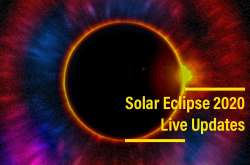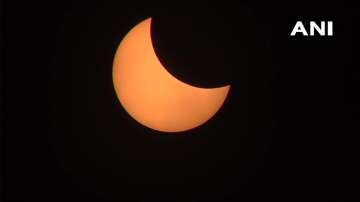Amid magnificent glare and 'Ring of Fire' India bears witness to the historic Solar Eclipse 2020 | Highlights
Solar Eclipse 2020 marked one of only 5 such instances where a maximum solar eclipse was visible from India in a timeframe of the next 100 years. The annular belt of the eclipse in India passed through cities like Joshimath and Dehradun in Uttrakhand, Sirsa in Haryana, parts of Rajasthan, but the eclipse was witnessed from every corner of the country. India witnessed the magnificent 'Ring of Fire' and saw the skies turn dark as the Moon overshadowed the mighty Sun. Delhites were left disappointed since overcast weather deprived them of the historic sight.

Solar Eclipse 2020 marked one of only 5 such instances where a maximum solar eclipse was visible from India in a timeframe of the next 100 years. The annular belt of the eclipse in India passed through cities like Joshimath and Dehradun in Uttrakhand, Sirsa in Haryana, parts of Rajasthan, but the eclipse was witnessed from every corner of the country. India witnessed the magnificent 'Ring of Fire' and saw the skies turn dark as the Moon overshadowed the mighty Sun. Delhites were left disappointed since overcast weather deprived them of the historic sight.
What is Solar Eclipse?
A solar eclipse is witnessed when the moon passes between the Earth and the Sun. During the Surya Grahan phenomenon, the image of the Sun is totally or partly obscured. In the case of an annual solar eclipse, the moon's apparent diameter is smaller than that of the Sun. The phenomenon also blocks most of the sunlight, causing the Sun to look like an annulus (ring). An annular eclipse appears as a partial eclipse over a region of the Earth thousands of kilometers wide.
Highlights
13:23 pm: Visuals from Nepal

12:47 pm: Delhites deprived of the 'Ring of Fire' thanks to overcast weather
The Solar Eclipse 2020 is well and truly showing its magnificent glares in the skies over India, but the resident of Delhi have been left disappointed as overcast weather deprives them of the clear view of the ring of fire. Earlier in the day, rains lashed out across the national capital and people feared that it might come to this. Read More and view images from Delhi-NCR
12:21 pm: Most spectacular view in India comes from Dehradun
12:15 pm: No matter where you are, people must take safety precautions while watching!!
People sometimes try to dare and take risks to watch the solar eclipse through naked eyes, x-ray sheets, or water reflection. However, no matter where you are, people must take safety precautions to watch the eclipse safely.
There is no part of an annular eclipse during which it is safe to look directly at the sun. People should use a proper solar filter or an indirect viewing method during all phases of the eclipse.
According to NASA, even if only a tiny silver of the Sun is visible around the moon's edge, that's still enough to cause damage to your eyes.
12:05 pm: Overcast weather hampers clear visuals in Delhi
11:47 am: Visuals from Amritsar
11:42 am: Visuals from Karachi, Pakistan
11:32 am: Sun slowly emerging out of the shadow of the Moon over Abu Dhabi, Oman.
11:30 am: Visuals from Uttarakhand
11:12 am: 80% Sun overshadowed by the Moon in UAE
11:02 am: NASA advises caution!!!
"No matter where you are, you must take safety precautions to watch the eclipse safely. There is no part of an annular eclipse during which it is safe to look directly at the Sun. You must use a proper solar filter or an indirect viewing method during all phases of the eclipse — even if only a tiny sliver of the Sun is visible around the Moon’s edge, that’s still enough to cause damage to your eyes," NASA has advised.
10:46 am: Annular Solar Eclipse visible in UAE
The United Arab Emirates (UAE) has witnessed the Annular Solar Eclipse. Watch Here
10:41 am: Solar Eclipse visible in Gandhinagar, Gujarat
10:33 am: Solar Eclipse visible in Mumbai
09:46 am: Moon makes first contact with the Sun at 9:15 am. Solar Eclipse 2020 in India officially begins.
09:43 am: Dos and Don'ts
India will witness a historic annular solar eclipse today. Such is the enormity of the eclipse that this is one of only 5 instances when India will witness a full solar eclipse in the next 100 years. So you must not miss the chance to experience the historic event. But you must also follow certain dos and don'ts if you do not want the Sun to permanently damage your eyes. Read the Dos and Don'ts Here
09:17 am: Temples in Lucknow to remain shut till 4:00 pm
09:00 am: Tirumala Temple close because of Solar Eclipse 2020
Lord Venkateswara Temple in Tirumala, which closed its doors last night at 8:30 pm, will remain closed for pilgrims today in light of the Solar Eclipse 2020. The temple will remain shut till 2:30 pm, post that, it will open but the devotees will not be allowed entry.
08:38 am: Jaipur to witness greatest phase of solar eclipse at 11.56 am today
Jaipur will witness the greatest phase of annular solar eclipse at 11:56 am (88% obscuration). “The astronomical significance of this solar eclipse is that this is happening on the summer solstice date - the longest day of the year. Second, the greatest eclipse phase will occur around 12 noon,” said Sandip Bhattacharya, assistant director, B M Birla Planetarium.
08:26 am: This is what happens in Solar Eclipse
08:19 am: Timings for Solar Eclipse in Indian cities
- Kolkata -- 10:46 am to 2:17 pm
- New Delhi -- 10:20 am to 1:48 pm
- Mumbai -- 10:00 am to 1:27 pm
- Chennai -- 10:22 am to 1:41 pm
- Bengaluru -- 10:13 to 1:31 pm
08:16 am: The annular eclipse will first start for the people of Congo in Africa and progress through South Sudan, Ethiopia, Yemen, Oman, Saudi Arabia, the Indian Ocean and Pakistan, before entering India over Rajasthan, pass through parts of Haryana, Uttarkhand before moving on to Tibet, China, Taiwan, and end up in the Pacific Ocean near Guam.
08:12 am: Rainfall has begun in Delhi, could hamper the visibility of the solar eclipse.
07:46 am: The reason why people are advised not to watch the Solar Eclipse 2020 with naked eyes is that when the Moon in directly between the Earth and the Sun, the rays from the Sun that reach the Earth are more powerful and can permanently damage our retina (most important part of the eye). When the Sun comes from behind the Moon the rays can surprise you and penetrate your eyes before you have a chance to look away.
This is even worse than when you normally look away from the sun because during the total eclipse, it is dark out, and your pupil, therefore, dilates so that it can let in enough light to get a good picture. Then, when the sun reappears and starts flooding the area with really bright light, not only are you staring straight at it, but your eye is in a state where it is wide open, and actively trying to let in as much light as possible.
07:21 am: IMD predicts rains across several parts of North India, which might hamper the view of the annular solar eclipse at some places.
7:09 am: Nasa tweeted about the solar eclipse late last night
06:42 am: Where in India will the Maximum Solar Eclipse be visible?
The rare eclipse on Sunday will be witnessed at its maximum from Joshimath—a city in Uttrakhand. The annularity belt of the eclipse—the region where the annular eclipse can be seen—will start from Rajasthan and pass through Haryana-Punjab-Uttarakhand. In addition to these places, Kurukshetra near New Delhi will also be able to witness the annularity. At the maximum time, nearly 98% of the solar disc would be occulted, which will lead to the formation of a Thin Ring of Fire in the sky.
Major Cities:
- Joshimath - Uttarakhand
- Kurushetra - Haryana
- Sirsa - Haryana
- Suratgarh - Rajasthan
- Yamuna Nagar - Haryana
- Dehradun - Uttarakhand
